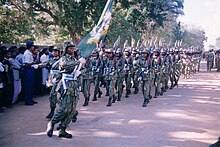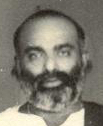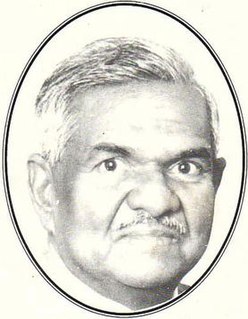Before independence
Early beginning

The arrival of Protestant missionaries on a large scale to Sri Lanka (then called Ceylon), beginning in 1814, was a primary contributor to the development of political awareness among Tamils. [4] The activities of missionaries from the American Board of Commissioners for Foreign Missions, Methodists and Anglican churches led to a revival among Tamils of the Hindu faith. Arumuga Navalar led a Hindu religious revivalist and reformist movement as a defensive response to the threat to their native culture posed by the British colonial and missionary activities. [4] He translated literary works to encourage the use of the Tamil Language and spread Hindu Saiva principles. Navalar's efforts to revive Hinduism, the predominant religion of the Sri Lankan Tamil people, influenced Tamils who built their own schools, temples, and societies, and who published literature to counter that of the missionaries. Thus, by 1925 nearly 50 schools, including the Batticotta Seminary, were fully functioning. [5] This revival movement also set the stage for modern Tamil prose. [6]
The success of this effort led the Tamils to think confidently of themselves as a community and prepared the way for their awareness of a common cultural, religious and linguistic kinship in the mid-nineteenth century. [4] [7] For these contributions to the Tamil people, Arumugam Navalar has been described as a leader who gave his community a distinct identity. [8]
Communal Consciousness
Great Britain controlled the whole island by 1815, and unified the country administratively in 1833 with a legislative council that acted as advisor to the Governor. The council was composed of three Europeans and one representative each of the Sinhalese, the Sri Lankan Tamils, and the Burghers. [9] But this situation changed in 1919 with the arrival of British Governor William Manning, who actively encouraged the idea of "communal representation". He created the reformed legislative council in 1921 and its first election returned thirteen Sinhalese and three Tamils, a significant loss in representation for the Tamils when compared to the previous council based on direct appointment by the governor. [10] [11] Because of this, the Tamils began to develop a communal consciousness and to think of themselves as a minority community. They focused on communal representation in the council rather than national representation, and decided that their delegates should be leaders from their own community. [10] This new sense of community identity changed the direction of Tamil nationalism. Starting in the mid-1920s, their developing national awareness transformed into a more active national consciousness, with a heightened determination to protect the interests of the Ceylon Tamil community. [8] Influenced heavily by political history and, perhaps more importantly, Colombo-centered developments of the British administration, this emerging Tamil national consciousness led to the establishment of the All Ceylon Tamil Congress headed by Tamil politician, G. G. Ponnambalam. [8] [12]
Development
Historic changes occurred in 1931: the reformed legislative council was eliminated, and the Donoughmore Commission, which rejected communal representation, was formed. Instead, the Commission introduced universal franchise, in which representation was proportionate to percentage of population. The Tamil leadership strongly opposed this plan, realizing that they would be reduced to a minority in parliament. Many Sinhalese were also against the idea of universal franchise for all castes.[ citation needed ] G.G. Ponnambalam publicly protested the Donooughmore Commission and proposed to the Soulbury Commission, which had replaced the Donooughmore Commission, that roughly equal numbers of congressional seats be assigned to Tamils and to Sinhalese in the new independent Ceylon being planned, but his proposal was rejected. From the introduction of the advisory council, through the Donoughmore Commission in 1931, to the Soulbury Commission in 1947, the primary dispute between the elite of the Sinhalese and Tamils was over the question of representation, not the structure of the government. This issue of power-sharing was used by the nationalists of both communities to create an escalating inter-ethnic rivalry which has been gaining momentum ever since. [12]
Ponnambalam's advocacy of Tamil nationalism was paralleled by a similar Sinhalese nationalism of Sinhala Maha Sabha, led by future Prime Minister Solomon Bandaranaike. This created tension between the two leaders and caused the exchange of verbal attacks, with Ponnampalam calling himself a "proud Dravidian". [13] This interethnic and political stress led to the first Sinhalese-Tamil riot in 1939. [14] (see Riots and pogroms in Sri Lanka )













